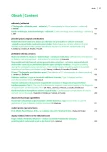Radiofrequency catheter ablation of atrial fibrillation performed under general anesthesia: results of a unicentric randomized trial
Authors:
Klára Stašková 1; Alan Bulava 1,2,3; Richard Tesařík 1; František Toušek 1
Authors‘ workplace:
Kardiologické oddělení Nemocnice České Budějovice, a. s.
1; Zdravotně sociální fakulta Jihočeské univerzity v Českých Budějovicích
2; I. interní klinika LF UP a FN Olomouc
3
Published in:
Vnitř Lék 2017; 63(3): 163-169
Category:
Original Contributions
Overview
Introduction:
Radiofrequency catheter ablation (RFA) has recently become a routine part of atrial fibrillation (AF) treatment. The goal of our study was to determine whether the implementation of RFA of AF under general anesthesia (GA), compared to analgosedation (AS), will affect important characteristics of the ablation procedure, comfort of the patient and whether there is any clinical impact on the complication rate and the overall success of the procedure.
Methods:
50 patients with AF were randomized in a ratio of 1 : 1 into two groups for RFA in AS and in GA. Procedural characteristics, arrhythmia-free survival for the time of 12 months and subjective evaluation of pain tolerability of the procedure were monitored.
Results:
Overall procedural times were comparable in GA and AS groups (111.2 ± 16.3 min vs 104.8 ± 25 min, p = NS). Time needed for preparation of patients was significantly longer in the GA group, while time needed for electrical disconnection of all pulmonary veins (PVs) was significantly shortened. Electrical isolation of the ipsilateral PVs after the last RF application was achieved in 94 % of lesions in GA and in 78 % of lesions in AS, respectively (p = 0.02). Shorter time of RF energy application to achieve electrical isolation of PVs was needed in the group of GA than in the group of AS (1 386 ± 387 s vs 1 745 ± 463 s, p = 0.005). Subjective discomfort evaluation of the procedure was more favorable in patients in the GA group. 88 % of patients in the GA group vs 68 % patients in AS (p = 0.1) had stable sinus rhythm off antiarrhythmic treatment during the 12 month period following the index procedure. While in the GA group all 3 patients with AF recurrence were willing to undergo another procedure in the GA, in the AS group only one patient out of 8 patients with AF recurrences underwent reablation.
Conclusion:
RFA of AF performed under GA provided improved tolerance and positive perception of the procedure, higher final treatment success and improved quality of life.
Key words:
general anesthesia – paroxysmal atrial fibrillation – pulmonary vein isolation – radiofrequency catheter ablation
Sources
1. Kirchhof P, Benussi S, Kotecha D et al. 2016 ESC Guidelines for the management of atrial fibrillation developed in collaboration with EACTS. Eur Heart J 2016; 37(38): 2893–2962.
2. Haissaguerre M, Jais P, Shah DC et al. Spontaneous initiation of atrial fibrillation by ectopic beats originating in the pulmonary veins. N Engl J Med 1998; 339(10): 659–666.
3. Pappone C, Oreto G, Rosanio S et al. Atrial electroanatomic remodeling after circumferential radiofrequency pulmonary vein ablation: efficacy of an anatomic approach in a large cohort of patients with atrial fibrillation. Circulation 2001; 104(21): 2539–2544.
4. Kautzner J. Je potřeba léčit agresivně fibrilaci síní? Vnitř Lék 2015; 61(5): 417–420.
5. Bulava A, Mokracek A, Hanis J et al. Sequential hybrid procedure for persistent atrial fibrillation. J Am Heart Assoc 2015;4(3): e001754. Dostupné z DOI: <http://dx.doi.org/10.1161/JAHA.114.001754>.
6. Di Biase L, Saenz LC, Burkhardt DJ et al. Esophageal capsule endoscopy after radiofrequency catheter ablation for atrial fibrillation: documented higher risk of luminal esophageal damage with general anesthesia as compared with conscious sedation. Circ Arrhythm Electrophysiol 2009; 2(2): 108–112. Dostupné z DOI: <http://dx.doi.org/10.1161/CIRCEP.108.815266>.
7. Sophocles A, Chen L, Lin D et al. Postoperative amnesia in a patient undergoing general anesthesia for electro-physiologic (EP) catheter ablation of an irritable atrial focus. Transl Perioper Pain Med 2014; 1(2): 35–38.
8. Rössel T, Paul R, Richter T et al. Management of anesthesia in endovascular interventions. Anaesthesist 2016; 65(12)12: 891–910.
9. Kanj MH, Wazni OM, Natale A. How to do circular mapping catheter-guided pulmonary vein antrum isolation: the Cleveland Clinic approach. Heart Rhythm 2006; 3(7): 866–869.
10. Eckardt L, Häusler KG, Ravens U et al. ESC guidelines on atrial fibrillation 2016: Summary of the most relevant recommendations and modifications. Herz 2016; 41(8): 677–683.
11. Di Biase L, Conti S, Mohanty P et al. General anesthesia reduces the prevalence of pulmonary vein reconnection during repeat ablation when compared with conscious sedation: results from a randomized study. Heart Rhythm 2011; 8(3): 368–372. Dostupné z DOI: <http://dx.doi.org/10.1016/j.hrthm.2010.10.043>.
12. Wasserlauf J, Knight BP, Li Z et al. Moderate Sedation Reduces Lab Time Compared to General Anesthesia during Cryoballoon Ablation for AF Without Compromising Safety or Long-Term Efficacy. Pacing Clin Electrophysiol 2016; 39(12): 1359–1365. Dostupné z DOI: <http://dx.doi.org/10.1111/pace.12961>.
13. Malcolme-Lawes LC, Lim PB, Koa-Wing M et al. Robotic assistance and general anaesthesia improve catheter stability and increase signal attenuation during atrial fibrillation ablation. Europace 2013; 15(1): 41–47. Dostupné z DOI: <http://dx.doi.org/10.1093/europace/eus244>.
14. Reddy VY, Shah D, Kautzner J et al. The relationship between contact force and clinical outcome during radiofrequency catheter ablation of atrial fibrillation in the TOCCATA study. Heart Rhythm 2012; 9(11): 1789–1795. Dostupné z DOI: <http://dx.doi.org/10.1016/j.hrthm.2012.07.016>.
Labels
Diabetology Endocrinology Internal medicineArticle was published in
Internal Medicine

2017 Issue 3
Most read in this issue
- Contribution of CT colonography to clinical practice
- Effectiveness of education in diabetes care management – instructions for educators
- Radiofrequency catheter ablation of atrial fibrillation performed under general anesthesia: results of a unicentric randomized trial
- Irregular breathing during the cardiopulmonary exercise test – from mildly irregular breathing pattern to periodic breathing of oscillatory ventilation type
